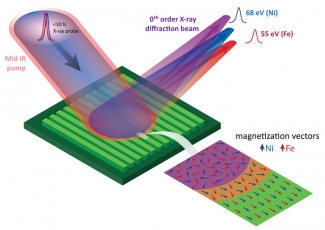Imagine being able to observe how a magnet works at the nanoscale level, both in space and in time. For instance, how fast does a nanoscale magnetic material switch its orientation? What if understanding magnetic switching might lead to the use of the spin of an electron rather than its charge to create new devices? A new method for investigating such possibilities is just beginning to be explored.
In 2009, an international research team from JILA, NIST-Boulder, and Germany used ultrafast bursts of X-rays to explore the speed with which the magnetic orientation of iron (Fe) and nickel (Ni) atoms in an 80% nickel–20% iron magnetic alloy could be destroyed by an intense infrared (IR) laser pulse. To watch this happen, the research team used a tightly focused and ultrafast (<<10 fs) tabletop X-ray strobe light to illuminate a slice of the alloy, then study the signals emitted from each element in the material, as shown in the figure.
The emitted signals came from each element’s "M edge," the place from which electrons excited by a laser move into empty valence bands. The M edges are unique for each element. Consequently, the researchers were able to use reflected X-ray beams from the M edges to determine what was happening to the magnetic orientation in the Fe and Ni atoms in response to illumination by an intense IR laser pulse. By studying the X-rays reflected from the different atoms, the international research team was able to "see" how fast the magnetic orientation in each element was destroyed by the IR light pulse. The team’s first-ever ultrafast observations of element-specific magnetic behavior in an alloy were accomplished with a record-setting time resolution of 55 fs.
JILA team members were graduate student Chan La-O-Vorakiat, former graduate student Mark Siemens (now a research associate in the Cundiff group) as well as Fellows Margaret Murnane and Henry Kapteyn. The NIST Electromagnetics Division team members were Justin Shaw, Hans Nembach, and T. J. Silva. The University of Kaiserlautern team consisted of Stefan Mathias (now a Marie Curie Fellow in the Kapteyn/Murnane group) and Martin Aeschlimann, a former JILA Visiting Fellow. Patrik Grychtol, Roman Adam, and Claus M. Schneider of the Germany’s Institute of Solid State Research rounded out the collaboration.
The success of the collaboration’s experiment could lead to improvements in the writing speed in information storage devices. It may also bring researchers one step closer to creating revolutionary new devices that are more energy efficient and smaller than today’s electronics devices. It will definitely lead to additional experiments (with the table-top X-ray laser) aimed at understanding the magnetic behavior of such elements as Ni and Fe in magnetic compounds.
The collaboration’s success has put it a step ahead of researchers who still use ultrafast lasers to explore magnetism. Ultrafast lasers can only generate a combined magnetic signal from all elements in a material. Other research groups use building-sized synchrotron facilities to produce bursts of X-rays to study magnetism and other material properties. However, these bursts are too slow (>100 fs) to probe the fastest electron motions. - Julie Phillips




